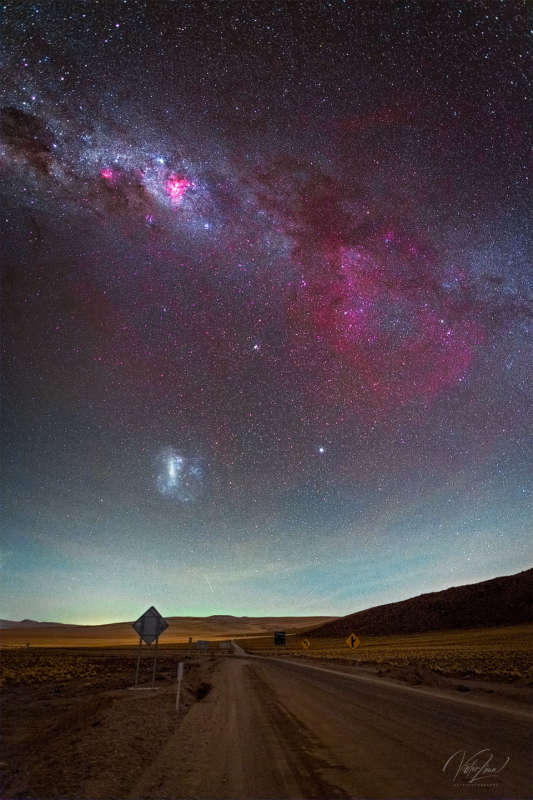
|
Credit & Copyright: Victor Lima
Explanation:
Because the Gum Nebula is the closest
supernova remnant,
it is actually hard to see.
Spanning 40
degrees across the sky, the nebula appears so
large and faint that
it is easily lost in the
din of a bright and complex background.
The Gum Nebula is
highlighted nicely in red emission toward the right of
the featured wide-angle, single-image photograph taken in
late May.
Also visible in the frame are the
Atacama Desert in
Chile
in the foreground,
the Carina Nebula in the plane of our
Milky Way galaxy running
diagonally down from the upper left, and the neighboring
Large Magellanic Cloud (LMC) galaxy.
The Gum Nebula is
so close that we are much nearer the
front edge than the back edge,
each measuring 450 and 1500
light years respectively.
The
complicated nebula lies in the direction of the
constellations of Puppis and Vela.
Oddly, much remains unknown about the Gum Nebula, including the
timing and even number of supernova explosions that formed it.
|
January February March April May June July August September October November December |
| ||||||||||||||||||||||||||||||||||||||||||||||||
NASA Web Site Statements, Warnings, and Disclaimers
NASA Official: Jay Norris. Specific rights apply.
A service of: LHEA at NASA / GSFC
& Michigan Tech. U.
Based on Astronomy Picture
Of the Day
Publications with keywords: Gum Nebula - supernova remnant
Publications with words: Gum Nebula - supernova remnant
See also:
- APOD: 2025 October 1 Á NGC 6960: The Witchs Broom Nebula
- APOD: 2025 June 9 Á Between Scylla and Charybdis: A Double Cosmic Discovery
- Supernova Remnant Cassiopeia A
- APOD: 2025 January 8 Á Supernova Remnants Big and Small
- APOD: 2024 September 18 Á The Mermaid Nebula Supernova Remnant
- APOD: 2024 April 16 Á Filaments of the Vela Supernova Remnant
- APOD: 2024 April 3 Á Unusual Nebula Pa 30
